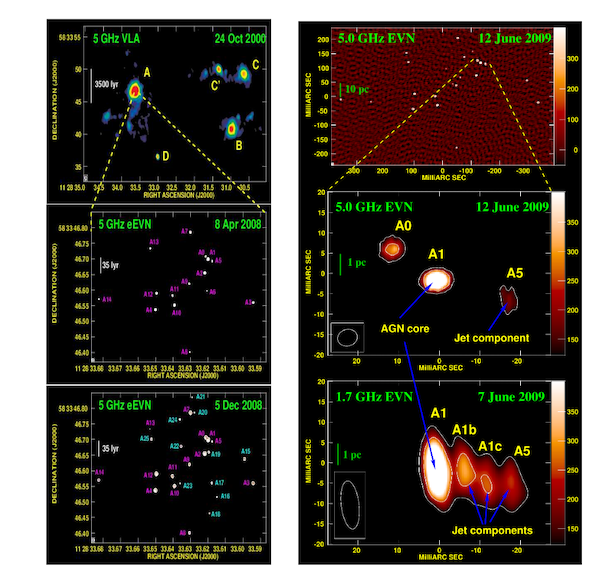
Star formation and nuclear activity in luminous infrared galaxies: an infrared through radio review
by Miguel Pérez Torres (Instituto de Astrofísica de Andalucía IAA-CSIC, Spain)

EVN images of the central 200 pc of Arp 299-A (bottom). Right: EVN image
at 5 GHz of the central 200 pc region of Arp 299-A (top), and blow-ups of the inner
8 parsecs as imaged with the EVN at 5.0 GHz (middle) and 1.7 GHz (bottom).

(left panels: pre-discovery image (top) and discovery image (bottom), develops into
an expanding jet structure as a fraction of the accretion power is channeled into a
relativistic outflow (right panel).
Nearby galaxies offer unique laboratories allowing multi-wavelength spatially resolved studies of the interstellar medium, star formation and nuclear activity across a broad range of physical conditions. In particular, detailed studies of individual local luminous infrared galaxies (LIRGs) are crucial for gaining a better understanding of these processes and for developing and testing models that are used to explain statistical studies of large populations of such galaxies at high redshift for which it is currently impossible to reach a sufficient physical resolution.
In a recent review (Pérez-Torres et al. 2021), we provide an overview of the impact of spatially resolved infrared, sub-millimetre and radio observations in the study of the interstellar medium, star formation and active galactic nuclei as well as their interplay in local LIRGs. We also present an overview of the modelling of their spectral energy distributions using state-of-the-art radiative transfer codes. Those codes are also a powerful ‘workhorse’ tools for the study of LIRGs (and their more luminous counterparts) at higher redshifts, and whose morphology cannot be spatially resolved. We also discuss how spatially-resolved time domain observations have recently opened a new window to study the nuclear activity in LIRGs.
Finally, we describe in detail the observational characteristics of Arp 299, one of the best studied local LIRGs, to exemplify the power of combining high-resolution observations at infrared to radio wavelengths, together with radiative transfer modelling used to explain the spectral energy distributions of its different components.
Radio interferometric observations at the highest angular resolution, i.e., VLBI, play a very relevant role in the review. This role is summarised in Figures 1 and 2, all of them of the iconic LIRG Arp 299. Figure 1 (left panel) shows 5 GHz VLA archival observations of Arp 299 (top), displaying the five brightest knots of Arp 299, while the bottom panels show 5.0 GHz EVN images of the central 200 pc of Arp 299-A on 8 April 2008 and 5 December 2008. The EVN clearly reveals a large population of compact, non-thermal emitting sources (white contours), mostly identified with young radio SNe and SN remnants (Pérez-Torres et al. 2009; Bondi et al. 2012). On the right panel of Figure 1, we show an EVN image at 5 GHz of the central 200 pc region of Arp 299-A (top panel), and blow-ups of the inner 8 parsecs, as imaged with the EVN at 5.0 GHz (middle panel) and 1.7 GHz (bottom panel). The morphology, spectral index and luminosity of the A1–A5 region are very suggestive of a core-jet structure. Finally, in Figure 2 we show the first observations of a resolved radio jet in a TDE ever, obtained using VLBI observations. The initially compact, unresolved 8.4 GHz radio source in the nuclear region of Arp 299-B (left panels: pre-discovery image (top) and discovery image (bottom), develops into an expanding jet structure as a fraction of the accretion power is channeled into a relativistic outflow (right panel).
In the review, we summarise previous achievements obtained using high-spatial resolution observations and provide an outlook into what we can expect to achieve with future facilities.
We hope this article is of use to the whole community, but especially for undergraduate and graduate students interested in the diversity of phenonema that take place in LIRGs, and how VLBI can help, sometimes in truly unique ways, to solve puzzling mysteries.
Published in Perez-Torres et al. 2021. A&AR (doi:10.1007/s00159-020-00128-x).